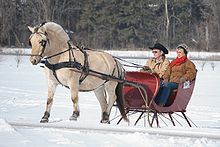



A sled, skid, sledge, or sleigh is a land vehicle that slides across a surface, usually of ice or snow. It is built with either a smooth underside or a separate body supported by two or more smooth, relatively narrow, longitudinal runners similar in principle to skis. This reduces the amount of friction, which helps to carry heavy loads.
Some designs are used to transport passengers or cargo across relatively level ground. Others are designed to go downhill for recreation, particularly by children, or competition (compare cross-country skiing with its downhill cousin). Shades of meaning differentiating the three terms often reflect regional variations depending on historical uses and prevailing climate.
In British English, sledge is the general term, and more common than sled.[1] Toboggan is sometimes used synonymously with sledge but more often to refer to a particular type of sledge without runners.[2] Sleigh refers to a moderate to large-sized, usually open-topped vehicle to carry passengers or goods, and typically drawn by horses, dogs, or reindeer.[3]
In American usage sled remains the general term[citation needed] but often implies a smaller device, often for recreational use. Sledge implies a heavier sled used for moving freight or massive objects. Sleigh refers more specifically than in Britain to a vehicle which is essentially a cold-season alternative to a carriage or wagon and has seating for passengers; what can be called a dog-sleigh in Britain is known only as a dog-sled in North America.
In Australia, where there is limited snow, sleigh and sledge are given equal preference in local parlance.[4]
- ^ "Collins 2012 digital edition".
- ^ "Collins 2012 digital edition".
- ^ "Collins 2012 digital edition".
- ^ The Macquarie Dictionary, 2nd ed. North Ryde: Macquarie Library. 1991.